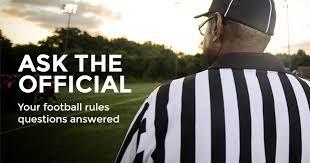Ask the Official: Shifts can include linemen until their hands go in the dirt

USA Football Rules Editor Bill LeMonnier is a veteran college referee who also has served as an official in the Arena Football League. He oversees the USA Football Rules Book. Click here to ask Bill a question. Make sure to put “Ask the Official” in the subject line.
Last year, we played a team that lined up in a traditional I-formation with five interior linemen, a tight end, a split end and a flanker, but prior to the snap the offense would shift where flanker stepped onto the line of scrimmage (covering the tight end) as a guard stepped back before pausing and going in motion – effectively starting to pull before the snap. I can’t find a rule that says this is illegal, but what is the call? Can an interior lineman be part of a shift like that?
The initial shift by the flanker is legal in NCAA, National Federation of High Schools and USA Football youth rules. When the tight end was covered by the flanker, the tight end became ineligible by position.
For the guard to shift, he could not do so from a three- or four-point stance. If he was and shifted, this would be a false start.
Assuming the guard was not restricted from legally shifting, another rule might apply: For many leagues, offenses must have five lineman on the line of scrimmage at the snap numbered 50 to 79. We assume after the shift by the guard, the offense has a numbering foul.
Either way, the call is a 5-yard, previous spot enforcement.
An interior lineman in a two-point stance can shift and go in motion – as long has as he never put his hand on or near the ground. Once his hand is on or near the ground, he is restricted from shifting.
I referee youth football as part of a three-man crew. Levels range from third to eighth grade. Where do you recommend positioning officials for the best field coverage? Third-graders rarely ever throw the ball, while eighth-graders will pass 20 to 30 percent of the time.
For years, we used a crew of three to work our youth and freshman games with a referee, umpire and linesman. Over the years, there has been a mechanics switch to move the three officials to umpire, linesman and line judge.
Covering both sidelines is important, and the umpire position allows for coverage up the middle. Even in situations where teams throw the ball, most passes will be 8 to 10 yards so the umpire, head linesman, line judge setup will work well.
On punts, the line judge can move downfield.
The key is to use your three officials where the game is being played and at the level of your players.
I was an umpire for a high school JV game where a running back and a linebacker met helmet-to-helmet at the line like a couple of butting rams. Our rules allow that kind of contact inside the tackle box, but if there ever was a play that should be discouraged it’s that one. Is there anything I could have done in that situation? I have no idea what I could have called, but I’ve never wanted to throw my flag more.
You officiate with the rules of the game and league you work for.
Expect continued emphasis on player safety rules, especially regarding helmet use and contact by runners. The NFL, National Federation of High Schools and USA Football all have current rules prohibiting runners from using their helmets against opponents. We expect the NCAA to follow suit in the future.
We agree totally with you that this type of play must be discouraged by coaches and league leadership. You might want to share USA Football’s Heads Up Football program with your league administrators, coaches and players. It is a comprehensive instructional program designed to make the game safer through proper teaching and coaching techniques. It is being recognized as the best instructional safety program for youth and high school players. Check it out at www.usafootball.com/headsup.
